Sherburn-Leicester-Wickenby-Sherburn
Sunday, 30th January 2011
In 2010 both Pete Mountain and I took up flying the new Archer III at Sherburn. We quickly came to the conclusion that this was a very fine plane to fly with all mod cons including GPS and auto-pilot plus enhanced ergonomics (much quieter and more comfortable). The plane was also even more inherently stable than the Warrior.
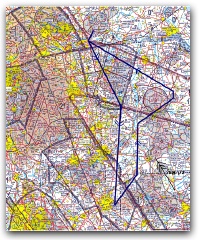 After our respective check out periods with Barry Davies, an instructor at Sherburn, we'd flown to
Conington, Wellesbourne and Halfpenny Green the previous August.
After our respective check out periods with Barry Davies, an instructor at Sherburn, we'd flown to
Conington, Wellesbourne and Halfpenny Green the previous August.
Today we were initially going to fly to Leicester and being unable to fly P1 as a result of a temporary medical condition, I'd offered to do the radio and navigation in order to share the workload.
During the winter period, and several aborted sorties due to weather, Pete and I had set about refining and validating a checklist.
Though the Archer was essentially a PA28, we felt there were enough differences from the Warrior to warrant a bespoke checklist (will take a couple of minutes to download).
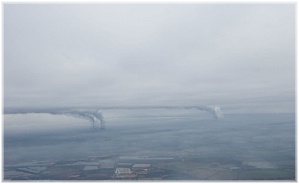
After the external and internal checks the next task was to get the engine started. Pete primed it and then pressed the start button.
The propeller winced into life, rotated once and then gave up. The battery was flat. Ironically we had just seen a pilot give up trying to start one of the Warriors and now it was our turn.
The engineering team came to our rescue with a 24 amp charger and within half an hour we were taxiing to runway 29.
On leaving the circuit and heading south, we said farewell to Sherburn and called up Fenton Approach who asked us to squawk 4540. A few minutes later at Ferrybridge I quickly requested a radio frequency change to Doncaster in order to negotiate the zone transit as soon as possible.
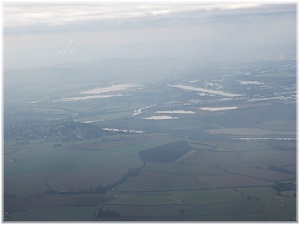
Doncaster asked us to squawk 6160 and cleared us to enter their zone VFR not above 2,500 feet on the Doncaster QNH 1025. We were provided with a Radar Service and asked to report leaving Gamston.
In my flight plan I'd estimated an elapsed time of 17 minutes to Gamston from Ferrybridge on a heading (adjusted for wind and magnetic variation) of 159°.
On the second Garmin box we set the VOR frequency 112.8 and checked the IDENT by pressing the NAV2 button and setting the V volume control.
The Morse code for GAM (--.\.-\--) sounded loud and clear. I rotated the HSI (Horizontal Situation Indicator) until the 155° to-radial came in and Pete started tracking to this.
Meanwhile I also set up the frequency on the DME (Distance Measuring Equipment) box as this runs independently of either Garmin box.
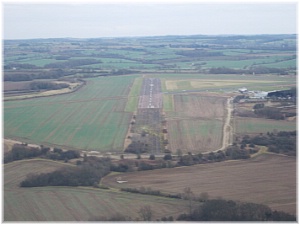
We reached Gamston on time and a few minutes after reporting our postion to Doncaster (and leaving their zone) we were asked to squawk 7000 and freecall East Midlands on 134.175.
I called up East Midlands, requested a Basic Service and zone transit en route to Leicester. We were provided with a Basic Service and cleared to enter the zone not above 2,000 feet on the East Midlands QNH 1024. We were also asked to squawk 4553 and IDENT.
At this point Pete was tracking the Gamston 010° from-radial. According to my plan it would take us 25 minutes to reach Leicester
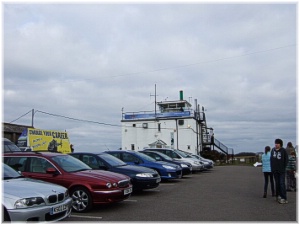
On the first Garmin box I set up the waypoint for Leicester and keyed in the airfield code EGBG. I zoomed out and could see that we were tracking directly towards it with 18 miles to run.
A few miles north of the airfield the visibility improved dramatically and, with the airfield in sight, I requested a radio frequency change to Leicester on 122.125. This was granted and we were asked to squawk 7000.
The airfield was very busy but I managed to get our call in for joining instructions and airfield information. The runway in use was one zero with a left hand circuit and the QFE was 1008.
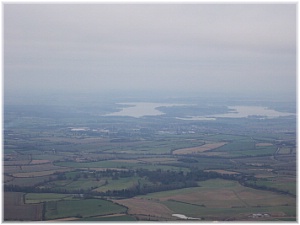
Pete negotiated the very busy circuit with ease. With two more planes joining overhead he descended on the deadside. Then we clocked a plane on the crosswind leg and followed this round. I made the downwind call and Pete lowered the flaps to slow down.
We followed the plane in front and which landed and cleared the runway in good time for us to land. We managed to park up on a grass verge near to one of the hangers and head for the club to pay our landing fee and grab a cup of tea.
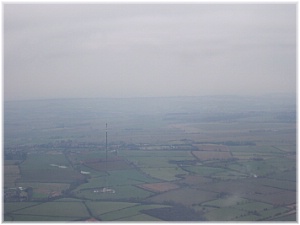
There we met a student pilot on his QXC out of Wycombe and about to fly the last leg home. We exchanged recollections of our QXCs.
Mine had taken me to East Midlands and Humberside and I suddenly realised I hadn't bumped into any other pilots en route (not private ones anyway).
We also got chatting to two pilots who flew out of Gamston but used to be members of Sherburn Aero Club.
Pete and I decided we would fly next to Wickenby. Whilst he made the Prior Permission call, I pondered the route.
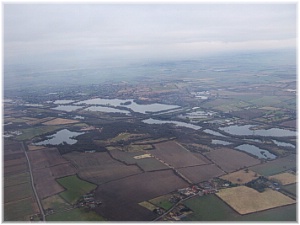
After much debate and re-drawing of lines on the chart we finally decided to fly out to the Waltham on the Wolds mast, up to Collingham just north of Newark and then negotiate a MATZ transit through Waddington overhead Lincoln.
I quickly put together a flight plan. We would need to maintain an altitude of 2,000 feet to remain clear of the mast.
Back out on the tarmac we radioed for taxi instructions and taxied to the disused runway and parking area adjacent to runway 10. Here Pete undertook the power checks.
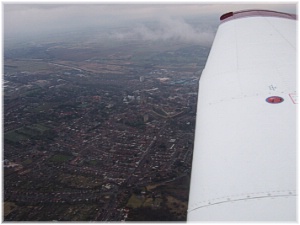
The airfield was busier than ever and we politely moved across to the other side of the asphalt area out of the way of an exiting aircraft, only to now find ourselves in a queue of three aircraft (still having not completed all our checks) waiting to backtrack 10 and take off!
Pete, as ever, took all this in his stride. As we lined up on the runway we noticed the plane in front (a bi-plane) do a very cheeky roll as it ascended on the upwind leg.
On leaving the circuit Pete steered onto our course for the mast at 14.58 and I'd calculated an estimated elapsed time of 8 minutes. I said farewell to Leicester and changed frequency to East Midlands who provided a Basic Service and advised the East Midlands QNH was 1023.
By this time we were flying back into murky skies and visibility wasn't as good as it had been around Leicester. We managed to clock the mast on our port side at 15.07 and Pete steered onto our northerly heading for Collingham.
We decided to call up Waddington as soon as possible so I requested a radio frequency change which was granted. Waddington provided a Basic Service, asked us to squawk 3606 and climb to 2,500 on their QFE of 1014. However I noted he hadn't cleared us through the MATZ at that point.
Pete attempted a climb but this took us into cloud so I advised Waddington we couldn't comply with the request as we wouldn't be able to maintain VFR. I also requested a zone transit en route to Wickenby once more and this was readily granted.
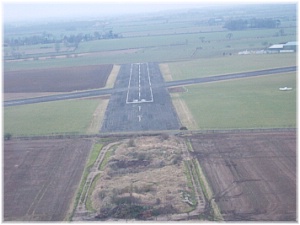
We changed to the calculated north-easterly heading for Wickenby at 15.34. Pete then spotted traffic coming directly towards us at the same level from our port side. The pilot of the plane acknowledged he was visual with us.
There was plenty of time for Pete to take avoiding action and I reported being visual with the Chipmunk as it went past a good distance away from us (Aviate, Navigate, Communicate!).
We were now approaching Wickenby from the south west and I requested a radio frequency change. Wickenby advised the runway in use was 34 and the QFE was 1022. We joined on the downwind leg and reported late downwind.
I recalled my first landing at Wickenby from the opposite direction. I'd nearly landed too far down the runway and decided to go around. I wasn't sure what had foxed me until I realised that it sloped upwards on runway 16 by 8 feet!
Back on the ground as Pete completed the shutdown checks we were conscious that we needed to turn around very smartly as we had to be back before official night.
We checked whether or not we needed to get some fuel and worked out from the Hobbs what our remaining endurance was. We established that we had enough fuel and reserve to get us home or to an alternate airfield.
Then I noticed the chipmunk landing and watched it taxi to the hanger in front of us...
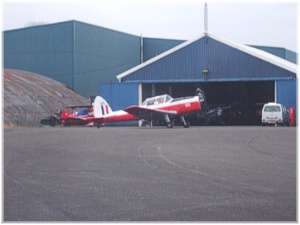
As luck would have it, as we left our plane, a very helpful guy stopped to give us a lift down to the club house in his car. Here we booked out again (no landing fee as they had reciprical arrangements with Sherburn Aero Club) and within half an hour we were back in the air.
We'd planned to head due north to Market Raisen (to avoid the Scampton MATZ) and then turn onto our heading for Sherburn.
Wickenby tower was now closed so I made blind calls until we were clear of the circuit. Then I changed frequency to Waddington who provided us with a Basic Service on the Barnsley QNH 1020.
With Market Raisen on the nose we said goodbye to Waddington and changed frequency to Humberside. They provided a Basic Service and asked us to squawk 4271. The ATC also advised that Hibaldstow (parachuting) was live.
As we planned shortly to change heading and track directly to Sherburn this was not a problem and I acknowledged receipt of the information.
We set up Sherburn as a direct waypoint on the GPS and, as we approached the Trent, I requested a radio frequency change to Doncaster. The ATC provided us with clearance through their zone not above 2,000 feet on the Doncaster QNH 1024 and asked us to squawk 6160.
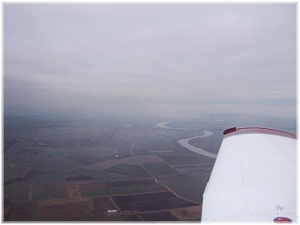
As we entered controlled airspace we noticed the bright lights of the car park adjacent to Sandtoft airfield and could make out Ferrybridge and Eggborough power stations in the distance.
We were then asked to descend to 1,500 feet and the warning bells went off in our heads. What was he separating us from we pondered? Then Jersey Eight Tango Xray announced he was established on the localiser.
The ATC advised that a Cherokee (us) was passing 1,000 feet below the approach. I switched on the navigation lights and Doncaster asked if we were visual with traffic approaching at our one o'clock. "Negative, looking out, Golf, Golf Charlie", I responded.
Then a few moments later the Dash-8 appeared from the clouds in all its glory just to our right and above us, the propellers creating a circular white flickering pattern against the grey sky.
"Visual with Dash-8, Golf Golf Charlie", I enthused impressed by the skills of Air traffic Control enabling General Aviation and Commercial traffic to safely co-exist.
Excitement over a few moments later, the ATC advised we could climb back to 2,000 feet. As we were close to Sherburn and would be entering the Church Fenton MATZ shortly we decided to stay at 1,500 feet.
On leaving Doncaster's zone I advised we had the airfield in sight and requested a radio frequency change to Sherburn on 120.60 which was granted. I contacted Sherburn for airfield information and Pete joined overhead on the QFE 1024 for a landing on two nine tarmac.
Back on the ground we bumped into the CFI, Pete Jackson. He had been up with a student pilot and they had overheard us on the radio. Did we get a good view of the Dash-8? "Most spectacular", we replied!

